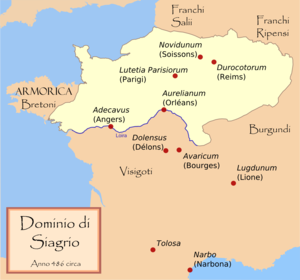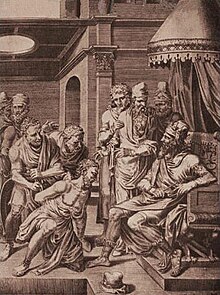Syagrius
Syagrius | |
|---|---|
| Born | 430 Gaul, Western Roman Empire |
| Died | 486–494 (aged 56–64) Toulouse, Visigothic Kingdom |
| Cause of death | Assassination |
| Known for | Final ruler of the Domain of Soissons, Roman Emperor |
| Battles / wars | Battle of Soissons |
| Children | at least 1 |
Syagrius (430 – 486[1] or 487 or 493–4[2]) was a Roman general and the last ruler of a Western Roman rump state in northern Gaul, now called the Kingdom of Soissons. Gregory of Tours referred to him as King of the Romans. Syagrius's defeat by King of the Franks Clovis I is considered the end of Western Roman rule outside of Italy. He inherited his position from his father, Aegidius,[3][4] the last Roman magister militum per Gallias. Syagrius preserved his father's territory between the Somme and the Loire around Soissons after the collapse of central rule in the Western Empire, a domain Gregory of Tours called the "Kingdom" of Soissons. Syagrius governed this Gallo-Roman enclave from the death of his father in 464 until 486, when he was defeated in battle by Clovis I.
Historians have mistrusted the title "Rex Romanorum" that Gregory of Tours gave him, at least as early as Godefroid Kurth, who dismissed it as a gross error in 1893. The common consensus has been to follow Kurth, based on the historical truism that Romans hated kingship from the days of the expulsion of Tarquin the Proud; for example, Syagrius's article in the Prosopography of the Later Roman Empire omits this title, preferring to refer to him as a "Roman ruler (in North Gaul)". However, Steven Fanning has assembled a number of examples of rex being used in a neutral, if not favorable, context, and argues that "the phrase Romanorum rex is not peculiar to Gregory of Tours or to Frankish sources", and that Gregory's usage may indeed show "that they were, or were seen to be, claiming to be Roman emperors."[5]
End of Roman Gaul
[edit]

Despite being isolated from the surviving portions of the Roman Empire, Syagrius managed to maintain a degree of Roman authority in northern Gaul for twenty years, and his state outlived the end of the Western Empire itself, the last Emperors being overthrown or killed in 476 and 480. Syagrius managed to hold off the neighboring Salian Franks, who were internally divided under kings including Childeric. However, it is known that Childeric had previously come to the aid of the Gallo-Romans, joining a certain officer named Paul in operations against Saxons who at one point seized Angers.[3][6]
Upon Childeric's death in 481 his son Clovis succeeded him. While Childeric had seen no need to overthrow the last Roman foothold in the west, Clovis assembled an army, issued a challenge, and met Syagrius's forces. Few details are known of the subsequent clash, the Battle of Soissons, but Syagrius was decisively defeated and fled. His domain passed to the Franks.[4]
As Edward Gibbon later wrote, "It would be ungenerous, without some more accurate knowledge of his strength and resources, to condemn the rapid flight of Syagrius, who escaped after the loss of a battle to the distant court of Toulouse."[7] Toulouse was the capital of Alaric II, king of the Visigoths. Intimidated by the victorious Franks, the Visigoths imprisoned Syagrius, then surrendered him to Clovis. He died not long after, stabbed in secret according to Gregory of Tours.[8]
Descendants
[edit]Despite the assassination of Syagrius, the family evidently prospered under Frankish rule. King Guntram sent a Count Syagrius on a diplomatic mission to the Byzantine Empire in 585. A member of the family, Syagria, made a large donation of land to the monks of Novalesa Abbey in 739. "The last known member of the Syagrii was an abbot of Nantua who was mentioned in 757."[9]
See also
[edit]Notes
[edit]- ^ "Syagrius of Burgundy, King of Soissons". Our Royal, Titled, Noble, and Commoner Ancestors & Cousins. Retrieved 9 September 2017.
- ^ Hughes 2015, pp. 207, 234.
- ^ a b Gregory of Tours 1916, II.18.
- ^ a b Gregory of Tours 1916, II.27.
- ^ Fanning 1992.
- ^ Gregory of Tours 1916, II,19.
- ^ Gibbon, Edward. "Chapter 38". Decline and Fall of the Roman Empire.
- ^ Gregory of Tours 1916, II.37.
- ^ Musset 1965, p. 127.
Further reading
[edit]- Fanning, Steven (1992). "Emperors and empires in fifth-century Gaul". In Drinkwater, John & Elton, Hugh (eds.). Fifth-Century Gaul: A Crisis of Identity?. Cambridge: University Press. pp. 288–297. ISBN 0-521-41485-7.
- Fleuriot, Léon (1980). Les origines de la Bretagne (in French). Paris: Éditions Payot. ISBN 978-2-22812-710-3.
- Gregory of Tours (1916). History of the Franks. Vol. book II. Translated by Earnest Brehaut. Retrieved 2021-04-03.
- Hughes, Ian (2015). Patricians and Emperors: The Last Rulers of the Western Roman Empire. Barnsley: Pen & Sword Books. ISBN 978-1-84884-412-4.
- Musset, Lucien (1965). The Germanic Invasions: The Making of Europe 400–600 AD. New York: Barnes & Noble Books. ISBN 978-1-56619-326-9.
